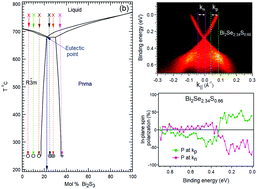Electronic properties of phases in the quasi-binary Bi2Se3–Bi2S3 system
Abstract
We explored the properties of the quasi-binary Bi2Se3–Bi2S3 system over a wide compositional range. X-ray diffraction analysis demonstrates that rhombohedral crystals can be synthesized within the solid solution interval 0–22 mol% Bi2S3, while at 33 mol% Bi2S3 only orthorhombic crystals are obtained. Core level photoemission spectroscopy reveals the presence of Bi3+, Se2− and S2− species and the absence of metallic species, thus indicating that S incorporation into Bi2Se3 proceeds prevalently through the substitution of Se with S. Spin- and angle-resolved photoemission spectroscopy shows that topological surface states develop on the surfaces of the Bi2Se3−ySy (y ≤0.66) rhombohedral crystals, in close analogy with the prototypical case of Bi2Se3, while the orthorhombic crystals with higher S content turn out to be trivial semiconductors. Our results connect unambiguously the phase diagram and electronic properties of the Bi2Se3–Bi2S3 system.



 Please wait while we load your content...
Please wait while we load your content...